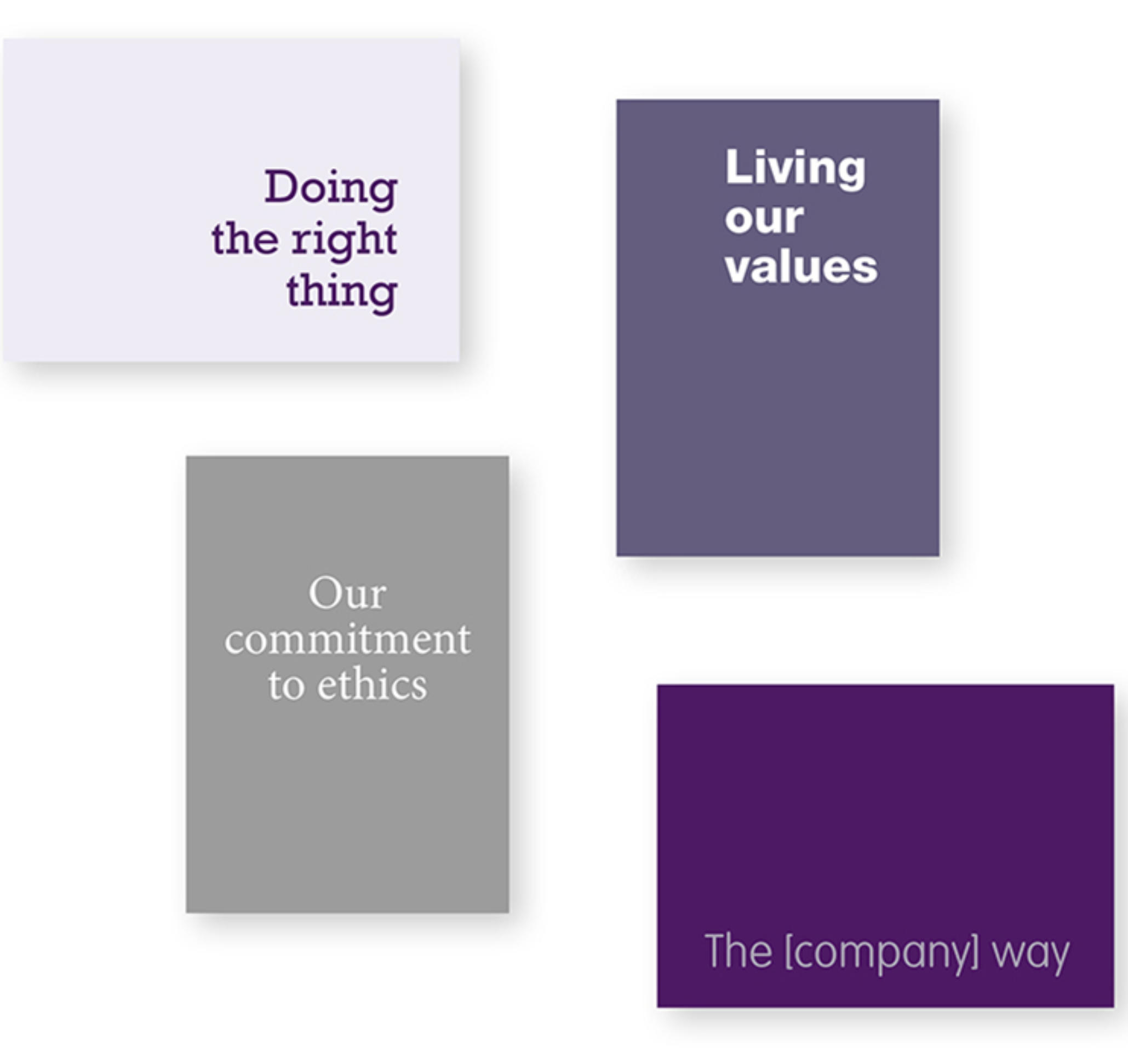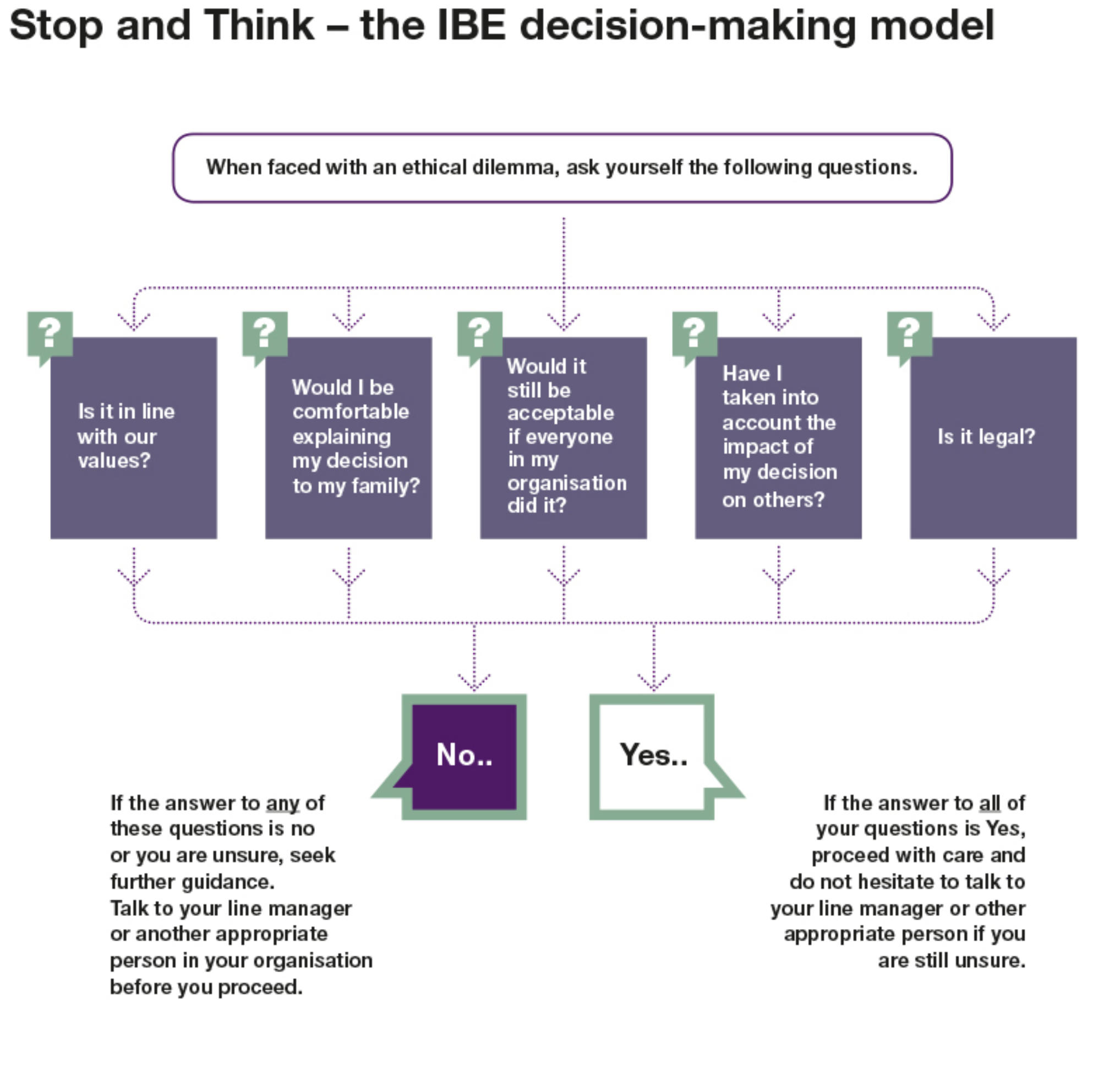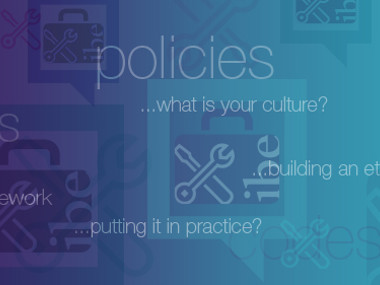Write a code
A code of ethics is an important tool for organisations that want to formalise their commitment to ethics. It cannot be stressed enough that merely endorsing an external standard or copying a code from another organisation will not suffice. Each organisation has its own particular history, ways of working and culture.
Here you can find an outline of what the code or ethics statement might look like and what the different sections should contain, as well as the IBE's suggestions on how to make them effective. It is important to point out that a code does not have to be a long document. In some cases, a relatively short statement that illustrates your organisation's values and main commitments can be sufficient.
1. The title
FIND THE RIGHT TITLE FOR YOUR CODE, WHICH RESONATES WITH YOU AND YOUR EMPLOYEES
The title is important because it communicates the purpose of your code of ethics: your employees and clients need to be able to recognise immediately that it will be of use to them. We suggest opting for a title that is inclusive and focuses on the individual responsibility for ethics and on employees' empowerment. Here are some examples:

2. The core values
DON’T FORGET YOUR VALUES
Your core values should be emphasised and made explicit right at the beginning of your code, so that it is clear that the standards of behaviour are based on those values.
For more details about how to define your core values, see the relevant step in the section Build the framework included in this Toolkit. Some examples of frequently used value words are the following:
Honesty: good business relationships are built on honesty. We are always open and honest with each other and with our clients.
Respect: the people we work with are important to us. We treat each other and our stakeholders with respect, no matter what.
Trustworthiness: We keep our promises and we do what we say we’d do. We want to be a trusted partner for all those who work with us.
Courage: Ethical questions are rarely easy and addressing them requires courage.
You can find more details about how your values can be applied in practice and used to prompt conversations about ethics among your staff in the dedicated section of this Toolkit.
3. Leadership endorsement
SET THE TONE FROM THE TOP
For the code of ethics to be effective, it is important that your employees feel that it is endorsed and supported by those at the top of the organisation. Including a personal message from the organisation’s leadership is a good way to do this. It doesn’t need to be long, but there are elements that help make it more effective:
- Mention of your core values and how important they are to build an ethical culture
- Leadership’s commitment to act as a role model and live up to the code
- Promotion of employee empowerment and ethical decision-making, making clear that ethics is everyone’s responsibility and people should use the core values to guide their own judgement when they face difficult situations.
- Support for those who have the courage to speak up about their ethical concerns, and assurance that they will be protected against retaliation.
4. How to use the statement, its purpose and scope of application
EXPLAIN TO PEOPLE HOW TO USE THE CODE
Include a brief explanation of the purpose of the code and of its scope. It doesn’t need to be too technical and legalistic, but it should provide enough information to make clear who should read the code or ethics statement and why.
Some of the things you might want to include in this section are:
- Why do we have this code? Many organisations explain that it is a tool to create a shared and consistent corporate culture and it provides guidance on how the core values are applied in practice.
- Who does the code apply to? Certainly it applies to your employees and everyone in your organisation, including those in senior positions. However, you may take this opportunity to state that you seek to do business with suppliers, clients and other third parties that share similar standards of behaviour. Many organisations take this opportunity to make it explicit that agents and temporary contractors are also subject to it.
- Some organisations use this section to highlight that those in managerial positions have additional responsibilities to act as role models and support their staff to live up to the organisation’s ethical standards.
5. Structure of the code/statement and the issues to cover
MAKE SURE THAT ALL THE ISSUES THAT ARE MOST RELEVANT TO YOUR ORGANISATION ARE INCLUDED
The way your code is structured can play an important role in improving the effectiveness of the document. In the downloadable templates you will find two different ways of doing it: one takes a values-based approach (in which issues are grouped according to your core values) and the other a stakeholder-based approach (in which issues are grouped depending on which stakeholder group they impact the most). It is also possible to take a hybrid approach, which is mix of the two options above.
Whatever approach you choose, remember to include the most relevant ethical issues that your organisation might face. Some of the most frequent ethical issues are presented in the section Consider the issues in this Toolkit.
6. Speaking up and raising concerns
PROVIDE YOUR EMPLOYEES WITH THE INFORMATION AND CONTACT DETAILS THEY NEED TO RAISE A CONCERN
Having in place a mechanism for employees to raise their concerns is crucial to promote an open culture (see The Ethics Framework included in this Toolkit). The code of ethics is a great place to remind employees of the options available to them. This section can be as detailed as appropriate for the size of your organisation and the tools you have in place. However, it is important that it includes:
- Clear indication of who to contact and by what means (phone, e-mail, post, live chat etc.) they can be contacted
- Assurance that those who raise their concerns will be protected against retaliation, but that there will be consequences if reports are malicious
- An explanation of the process that your organisation has in place to address the concerns raised
- An explanation of the consequences of breaching the code or ethics statement.
The IBE Speak Up Toolkit is a good starting point that you can use to think about the experience of raising a concern about ethics from the point of view of the reporter.
7. Decision-making guide
SUPPORT YOUR EMPLOYEES IN MAKING GOOD DECISIONS
The general nature of ethics means that codes cannot cover every situation in which an employee may find themselves. With this in mind, your code should offer further guidance to staff through a decision-making model or guide. This encourages them to use their own judgement and ask when they are unsure about something.
The IBE has developed the following test to self-assess an ethical dilemma:
- Transparency: Do I mind others knowing what I have decided?
- Effect: Who does my decision affect or hurt?
- Fairness: Would my decision be considered fair by those affected?
Another useful point to consider is the long term perspective and impact of a decision: how will it be perceived in – say – five years’ time?

8. Q&As and scenarios
Including in the code or ethics statement some short Q&As and scenarios brings the document to life and can prompt discussion about ethics among your staff. It is also a good opportunity to address some of the most common questions that your employees might have.
An example might be:
A new important business opportunity in another country has opened up and I need to get a work visa to travel abroad and pursue it in a relatively short time. The official procedure takes a long time and I’m not sure I can get the document soon enough. The person processing my application told me that they can speed up the process in exchange for a small extra fee in cash. Should I pay?
You should pay only if it represents a standard and official fee, part of a publicly available fast-track service. If not, it falls into the definition of facilitation payments (often known as grease payments), which is a form of bribery and it is therefore illegal. It may put yourself and your organisation at risk of prosecution. Always ask for a receipt when you make this kind of payment and, if possible, prefer non-cash transactions. The Serious Fraud Office (SFO) offers more detailed guidance on how to say no to facilitation payments. The IBE Say No Toolkit is another useful resource that can provide guidance in similar circumstances.
These Q&As will be most effective if they are tailored to your business and truly reflect situations that people do encounter when they are at work. However, in the downloads section you can find a collection of examples ordered by issue.
9. Some final considerations
Remember that:
- The code needs to be unique to your organisation.
- A date stamp either on the front or the back cover of the code helps your stakeholders make sure that the code is up to date and relevant.
- The code needs to be applicable to the entire workforce of the organisation.
- Organisations of international reach need to be aware of possible cultural differences, for instance related to language and customs.
- The language used throughout the code should be clear, inclusive and accessible.
- Technology can be a great enabler. Providing the code in different formats, such as video clips, sound bites, mobile apps, PDFs and print-outs will likely increase the likelihood that the code is widely read and understood.
- Similarly, providing the code as PDF, “pocket” and “credit card” versions should serve to increase the code’s accessibility and usability.
- Consider printing the organisation’s values on the back of business cards to make them more visible to your employees and other stakeholders.
- Including links and signposting to relevant policies, laws and regulations helps employees access all the resources available.
- Applying colours and design elements throughout the code increases readability and makes it more visually engaging.
Useful templates to get started
A code of ethics template

With the contribution of the companies in the Forum, we are working on the template of a code of ethics, which will be available for download from this page. Our suggestion is that you replace the examples that will be included and populate the framework with information and guidance specific to your culture to make it work for you.




